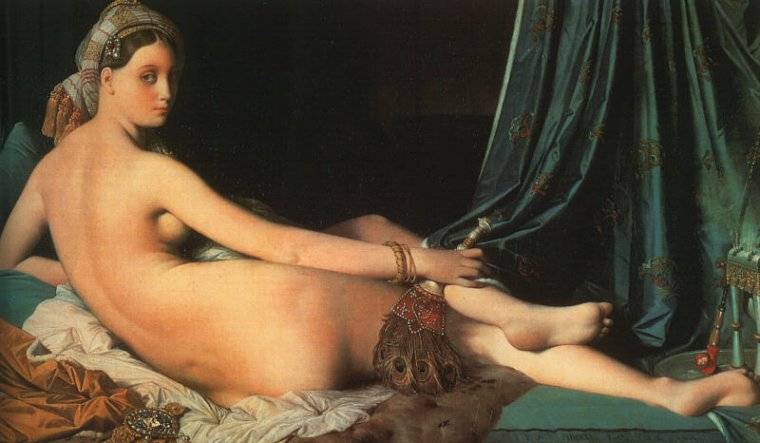- Grande Odalisque
Infobox Painting

painting_alignment=right
image_size=300px
title=Grande Odalisque
artist=Jean Auguste Dominique Ingres
year=1814
type=Oil on canvas
height=88.9
width=162.56
height_inch=35
width_inch=64
city=Paris
museum=Louvre "Grande Odalisque", also known as "Une Odalisque" or "La Grande Odalisque", is an
oil painting byJean Auguste Dominique Ingres depicting anodalisque , or concubine. Ingres' contemporaries considered the work to signify Ingres' break fromNeoclassicism , indicating a shift toward exoticRomanticism . "Grande Odalisque" attracted wide criticism when it was first shown. It has been especially noted for the elongated proportions and lack of anatomical realism. The work is housed in theLouvre inParis .History
The painting was commissioned by Napoleon's sister, Queen Caroline Murat of Naples,cite journal |last=Weston |first=Helen |year=1996 |title=A Look Back on Ingres |journal=Oxford Art Journal |volume=19 |issue=2 |pages=114–116 |accessdate=2008-01-09 |doi=10.1093/oaj/19.2.114] and finished in 1814. Ingres drew upon works such as Dresden Venus by
Giorgione , andTitian 'sVenus of Urbino as inspiration for his reclining nude figure. He portrays a concubine in languid pose as seen from behind with distorted proportions. The small head, elongated limbs, and cool color scheme all reveal influences from Mannerists such asParmigianino ,cite book|last=Kleiner|first=Fred|coauthors=Christian J. Mamiya|edition=12|title=Gardner’s Art Through the Ages|publisher=Wadsworth/Thompson Learning|date=2005|location=California |pages=826-827|isbn=0-534-64091-5] whoseMadonna with the Long Neck was also famous for anatomical distortion.This eclectic mix of styles, combining classical form with Romantic themes, prompted harsh criticism when it was first shown in 1814. Critics viewed Ingres as a rebel against the contemporary style of form and content. When the painting was first shown in the Salon of 1819, one critic remarked that the work had "neither bones nor muscle, neither blood, nor life, nor relief, indeed nothing that constitutes imitation".cite journal |last=Benjamin |first=Roger |year=2000 |month=December |title=Ingres Chez Les Fauves |journal=Art History |volume=23 |issue=5 |pages=754–755 |accessdate=2008-01-09 |doi=10.1111/1467-8365.00242] This echoed the general view that Ingres had disregarded anatomical realism.cite web |url=http://www.louvre.fr/llv/oeuvres/detail_notice.jsp?CONTENT%3C%3Ecnt_id=10134198673226311&CURRENT_LLV_NOTICE%3C%3Ecnt_id=10134198673226311&FOLDER%3C%3Efolder_id=9852723696500815&fromDept=true&baseIndex=5&bmUID=1189640260361&bmLocale=en |title=Une Odalisque |accessdate=2008-01-09 |work=Louvre Museum] Ingres instead favored long lines to convey curvature and sensuality, as well as abundant, even light to tone down the volume. Ingres continued to be criticized for his work until the mid-1820s.
Anatomy
Stemming from the initial criticism the painting received, the figure in "Grande Odalisque" is thought to be drawn with "two or three
vertebra e too many."cite journal |last=Maigne |first=Jean-Yves |coauthors=Gilles Chatellier, Hélène Norlöff |year=2004 |month=July |title=Extra vertebrae in Ingres' La Grande Odalisque |journal=Journal of the Royal Society of Medicine |volume=97 |issue=7 |pages=342–344 |url=http://www.pubmedcentral.nih.gov/articlerender.fcgi?artid=1079534 |accessdate= 2008-01-09 |doi=10.1258/jrsm.97.7.342] Critics at the time believed the elongations to be errors on the part of Ingres, but recent studies show the elongations to have been deliberate distortions.Citation |last=Hautefeuille |first=Annie |date=2 July 2004 |title=Little extra out the back |newspaper=The Australian |pages=16] Measurements taken on the proportions of real women showed that Ingres's figure was drawn with a curvature of the spine and rotation of the pelvis impossible to replicate. It also showed the left arm of the odalisque is shorter than the right. The study concluded that the figure was longer by "five" instead of two or three vertebrae and that the excess affected the lengths of the pelvis "and" lower back instead of merely the lumbar region.Given how the duty of concubines were merely to satisfy the carnal pleasures of the sultan, this elongation of her pelvic area may have been a symbolic distortion by Ingres. While this may represent sensuous feminine beauty, her gaze, on the other hand, has been said to " [reflect] a complex psychological make-up" or " [betray] no feeling". In addition, the distance between her gaze and her pelvic region may be a physical representation of the depth of thought and complex emotions of a woman's thoughts and feelings.
References
Wikimedia Foundation. 2010.
